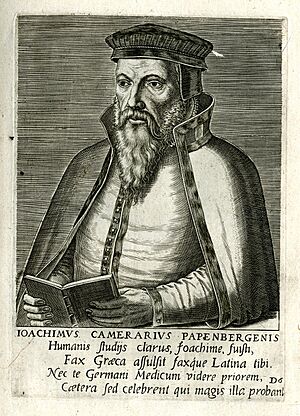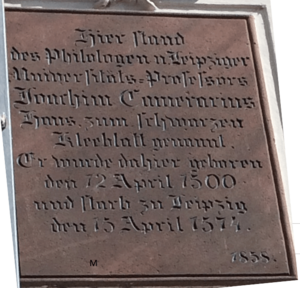Joachim Camerarius facts for kids
Joachim Camerarius (April 12, 1500 – April 17, 1574) was a very smart German scholar. He knew a lot about ancient Greek and Roman times. His deep understanding of old languages like Greek and Latin, along with his wide knowledge, made him one of the most important German scholars of his era.
Contents
A Life of Learning
Joachim Camerarius was born in Bamberg, Germany. His family's real name was Liebhard. But people often called him Kammermeister. This was because his family members had worked as a chamberlain for the bishops of Bamberg. A chamberlain was an important person who managed the household of a noble or a ruler.
Early Education and Friendships
Camerarius studied at several universities. These included Leipzig, Erfurt, and Wittenberg. At Wittenberg, he became a student and good friend of Philipp Melanchthon. Melanchthon was another very important scholar and a leader in the Reformation.
For some years, Camerarius taught history and Greek. He worked at a school in Nuremberg called the Ägidiengymnasium. In 1530, he went to the diet of Augsburg. This was an important meeting where he helped Melanchthon. Together, they worked on the Augsburg Confession. This was a key document for the Protestant movement.
Helping Universities and the Reformation
Five years later, Duke Ulrich of Württemberg asked him for help. Camerarius was asked to reorganize the University of Tübingen. He did a similar job in 1541 at Leipzig. He spent most of the rest of his life there.
Camerarius played a big part in the Reformation movement. This was a time of major changes in the Christian church. Many important leaders often asked him for his advice.
In 1535, he started writing letters to Francis I, the King of France. They talked about whether the Catholic and Protestant groups could find a way to get along. In 1568, Maximilian II also asked for his advice on this topic. Camerarius traveled to Vienna to meet with him. He passed away in Leipzig on April 17, 1574.
His Family
Joachim Camerarius was the father of Joachim Camerarius the Younger. His son became a well-known physician. His grandson, Ludwig Camerarius, was also an important person. Ludwig played a leading role during the Thirty Years' War. He was the head of the Palatinate government that was in exile.
His Important Works
Joachim Camerarius was a very busy writer and translator. He translated many important Greek books into Latin. These included works by famous writers like Herodotus, Demosthenes, Xenophon, and Homer. He also translated plays by Sophocles and writings by Lucian.
He published over 150 works in total. These included a list of important bishops and letters written in Greek. He also wrote a book about coins and a book about horsemanship called the Hippocomicus. Camerarius even wrote about his own travels in Latin poems. He also wrote biographies, which are life stories, of people he knew. These included Eobanus Hessus, George of Anhalt, Melanchthon, and Albrecht Dürer. His letters, published after he died, are very helpful for understanding his time.
Publishing Ancient Texts
Camerarius helped publish the first printed Greek version of Ptolemy's astrology book. This book was called the Tetrabiblos. It came out in 1535. He also translated parts of it into Latin and added his own notes.
He was also responsible for the first edition of Ptolemy's Almagest. This was another very important ancient book about astronomy. It was published in 1538.
Improving Playwright Texts
In 1552, Camerarius published an edition of the plays by the Roman writer Plautus. This was a big deal because he used the oldest existing copies of the plays. One of these old copies is still known today as the codex vetus Camerarii. This means "Camerarius's ancient book." His version of these plays was the best available for a very long time.



